Whether you’re just starting out with sourdough or you’ve been making it for years, you will love this easy overnight sourdough bread! This easy no knead sourdough bread recipe uses simple stretches instead of kneading. And, our step-by-step instructions make it perfect for beginners.
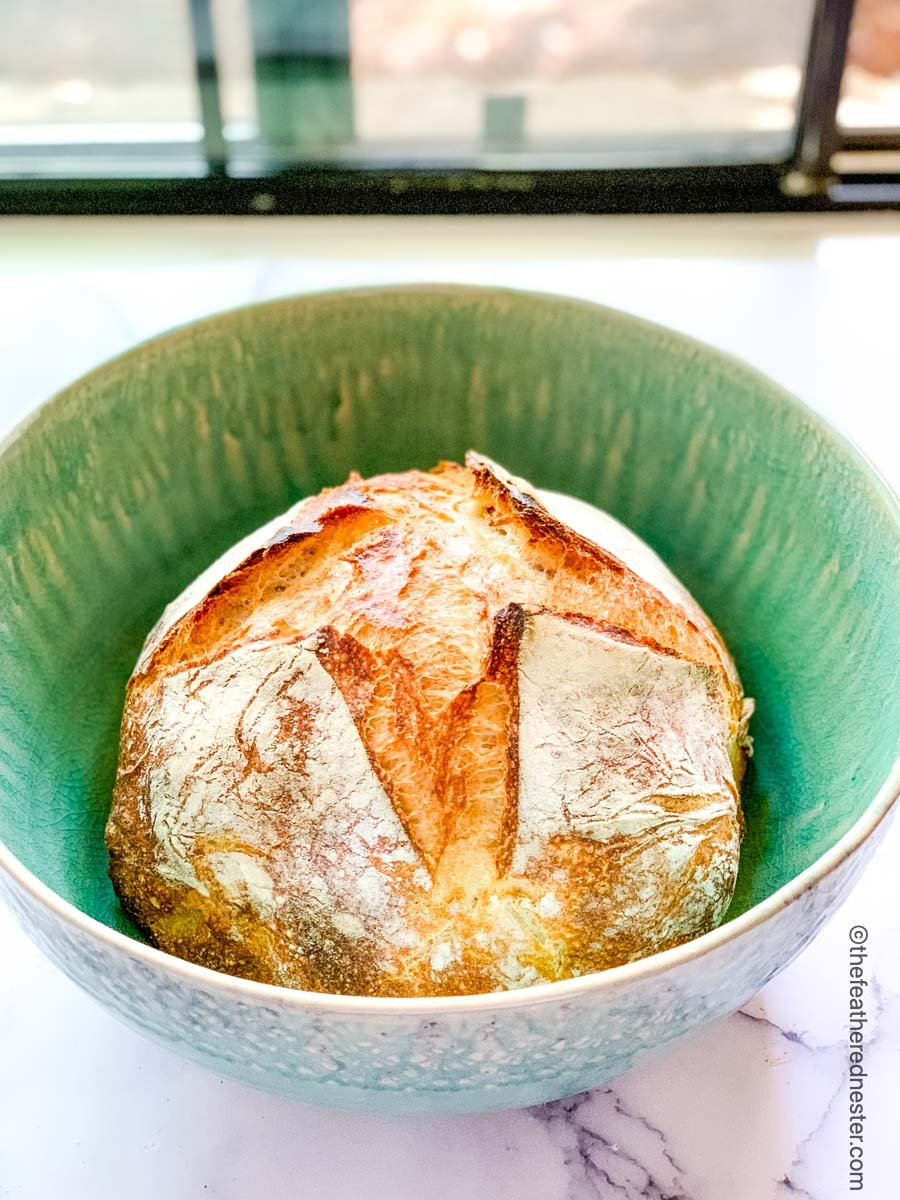
Content Covered Here
Why We Love This Recipe
- No kneading necessary!
Unlike many other recipes, this easy no-knead sourdough bread recipe does not involve kneading. Instead, it uses an easy folding technique that stretches the gluten. - It rises overnight and is ready to bake the next morning.
Sourdough is made with a naturally fermented wild yeast and needs a longer rise time than doughs made with commercial yeast. This fermentation allows the natural yeast the time needed to raise the dough.
An 8-10 hour rise is common for this overnight fermented or “bulk” rise.
So, prepare everything in the evening and let the dough rise overnight. - It’s an ideal way to use up your starter discard.
Our recipe uses a discard, so it’s perfect to make when it’s time to feed your starter. Unlike other recipes that use active starters at their peak, our easy sourdough bread recipe uses one that was fed 12-24 hours prior. Like our sourdough naan recipe, it is also perfect for beginners.
Ingredient Notes and Substitutions
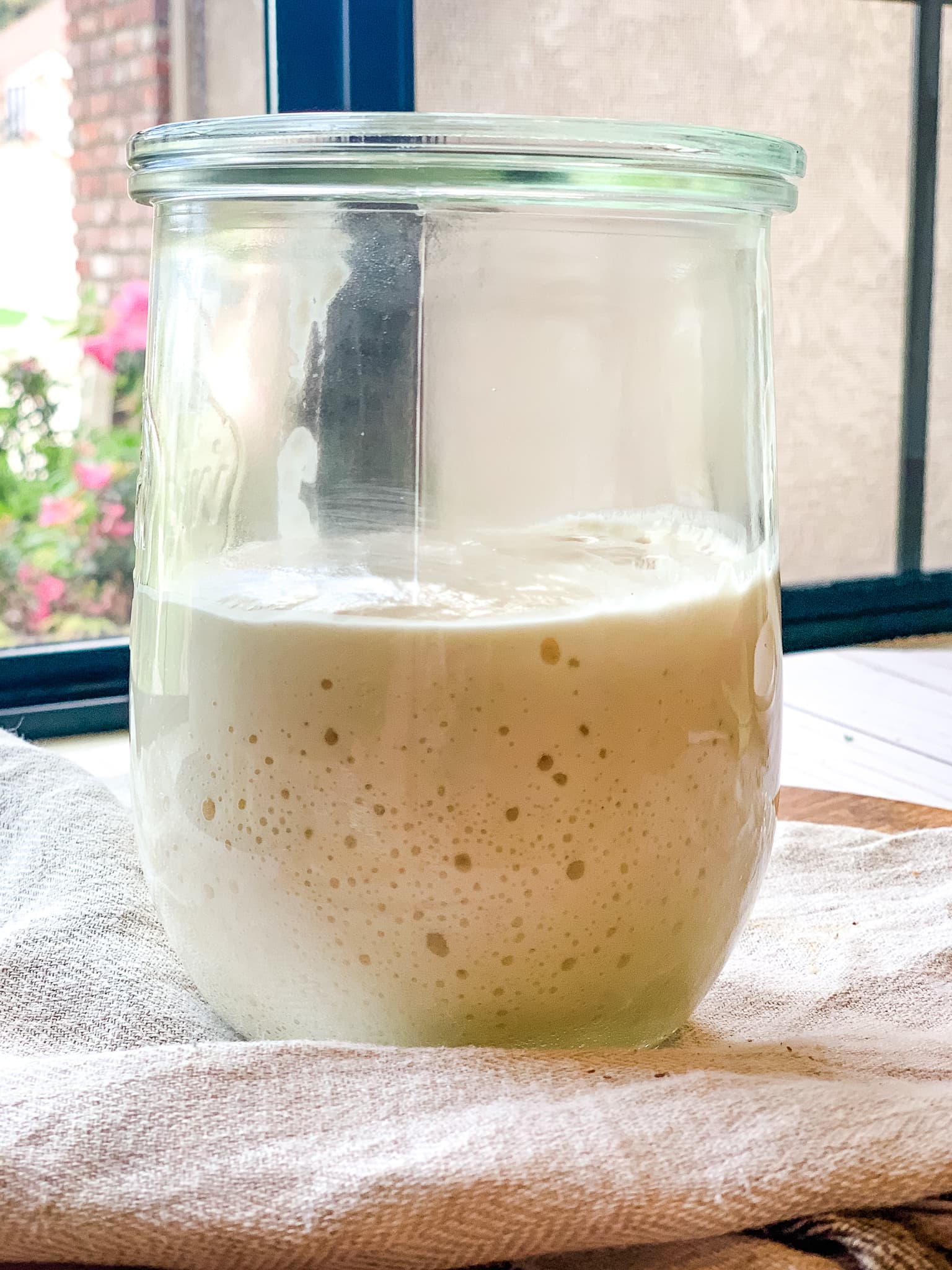
- Active Sourdough starter – fed 12-24 hours before starting the recipe.
When we say active, we mean a mature starter that is at least a week old and always doubles in size within 4-6 hours of feeding. It doesn’t mean you need to use it at the peak activity after a feeding. - Filtered water – or bottled water. Most tap water contains chlorine which can inhibit fermentation. If you must use tap water, leave the measuring cup out for at least 24 hours to let the chlorine dissipate.
- Bread Flour – or all purpose flour. I recommend using organic, unbleached flour.
- Fine salt – use fine table salt or fine sea salt. If you use Kosher salt, use about 25% more as Kosher salt is less “salty.”
If you need a starter, then our easy sourdough starter is literally fail-proof thanks to our pro tips. And it has step-by-step instructions, so it’s perfect for a beginner.
If you don’t have a sourdough starter, you can make this homemade sandwich bread or wheat sandwich bread that uses commercial yeast instead.
The fermentation process for our no knead sourdough bread creates gut-healthy enzymes and acids. Most yeast breads do not provide these healthy enzymes and acids.
How to Make This Easy Sourdough Bread Recipe
- Feed your starter at least 12-24 hours before starting the recipe.
You want a hungry starter that takes in the flour and water for energy and uses that to raise the dough.
Below is an example of the rise and activity after a feeding:
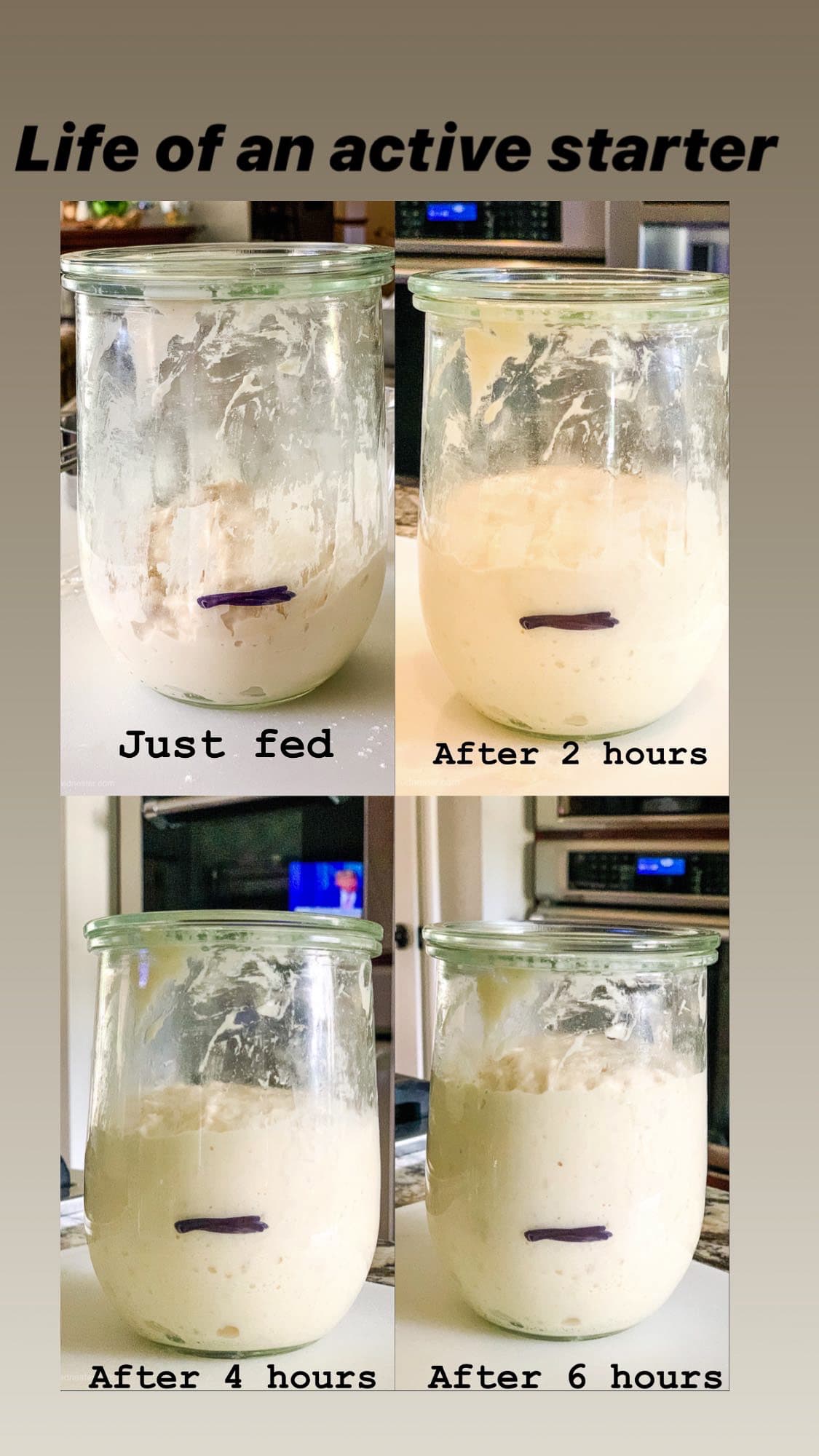
🎯 TFN Pro Tip
Store your artisan sourdough loaf at room temperature. For more tips, see our post on how to store sourdough bread.
- Mix the dough.
Use a mixing bowl to mix together starter, flour, water, and salt with a wooden spoon or a dough whisk until a thick, shaggy dough forms.
Then, cover the dough bowl with a clean, damp kitchen towel and let it rest for 30 minutes or so.
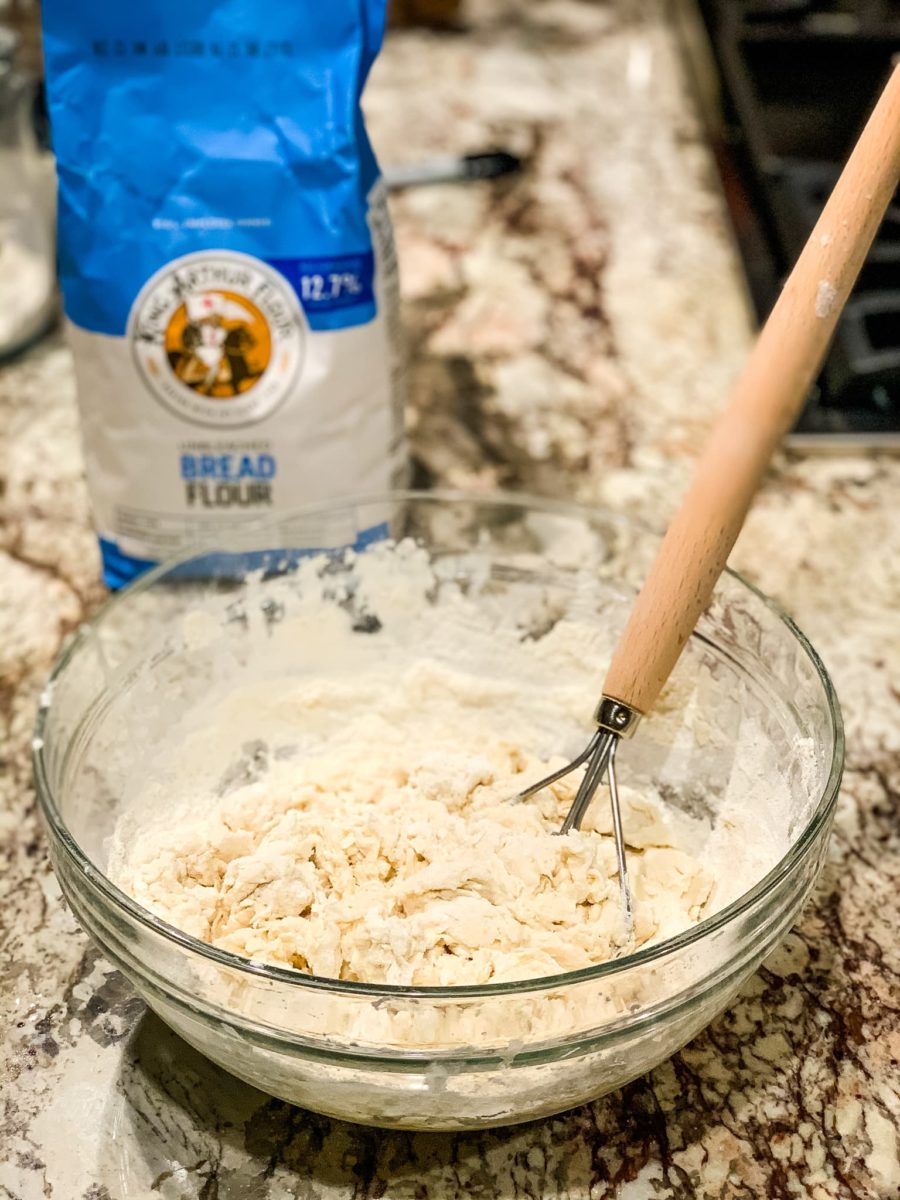
- Stretch the dough.
As mentioned earlier, we have a no-knead method for making overnight sourdough bread.
Simply pull up a section of the dough, stretch it out, push it into the back center of the dough, then turn the dough 1/4 a turn (see our video below in the recipe card).
Continue to pull, stretch, push, and rotate clockwise until you’ve gone in a circle.
Love to serve sourdough for breakfast? Here are some sourdough bread breakfast ideas for you: try our sourdough grilled cheese sandwich or lemon blueberry sourdough scones.
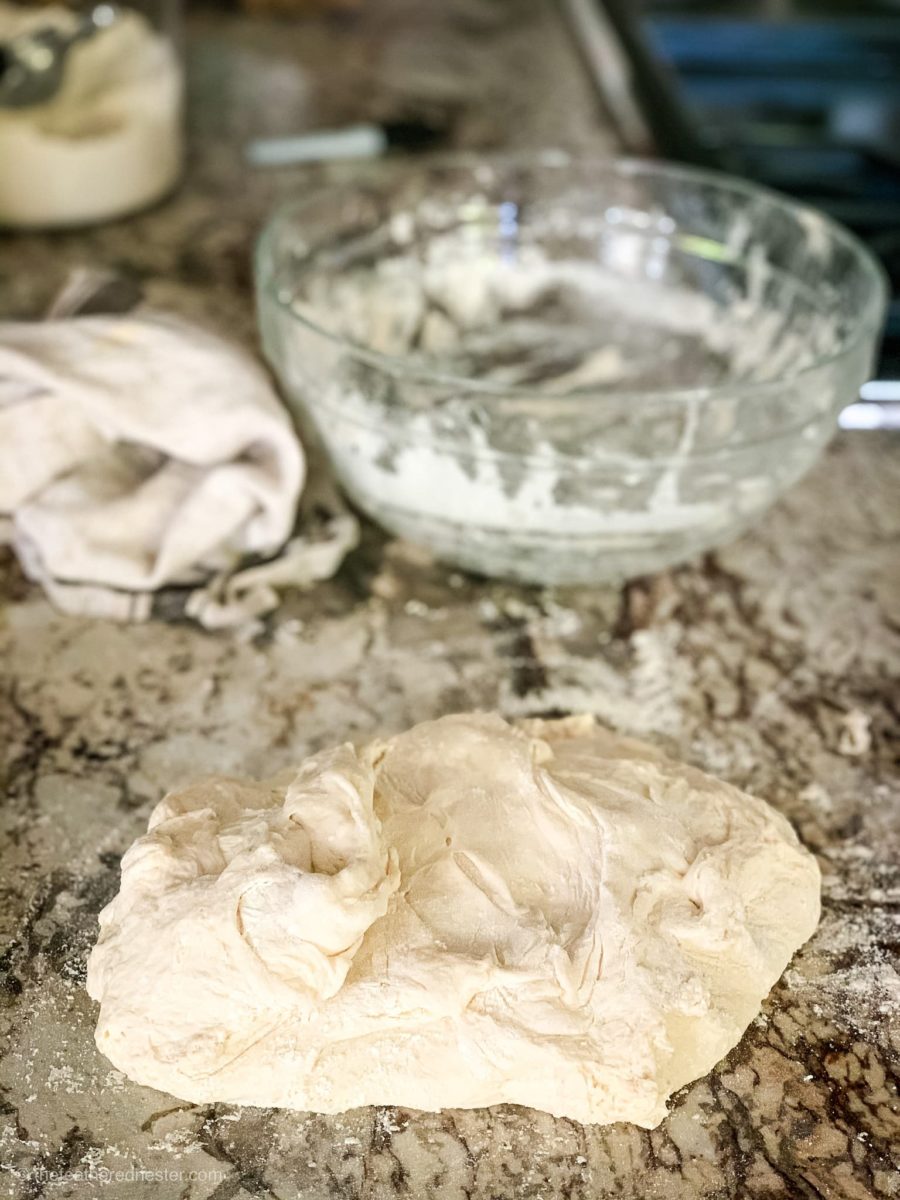
- Let the dough rise overnight for a bulk ferment.
Keep the dough in a warm area, free of drafts for the overnight rise. Do not place the dough in the fridge. Our recipe uses a room temperature rise.
Depending on the ambient temperature, this takes 8-10 hours, and sometimes even longer. Ideally, this should be in a room about 75° Fahrenheit. See our Overnight Rising Guidelines in the recipe below for estimated rising times.
Tips for keeping dough warm during colder months:
- Use a heated mat (like those used for germinating seeds) for rising.
- Use the “proof” setting of your oven (I set mine at 85ºF) and set a timer. This will speed up the rising process, so check it at 4 and 6 hours.
- If there is a sunny room in the house that stays warm, keep the dough covered in that area.
- Place the bowl in the oven with the door propped open and the light on to create a slightly warmer climate without actually turning the oven on.
🎯 TFN Pro Tip
Do not refrigerate the dough! Our recipe does not use a refrigerated rise. If it gets too cold, the fermented yeast will not rise overnight.
The Next Morning
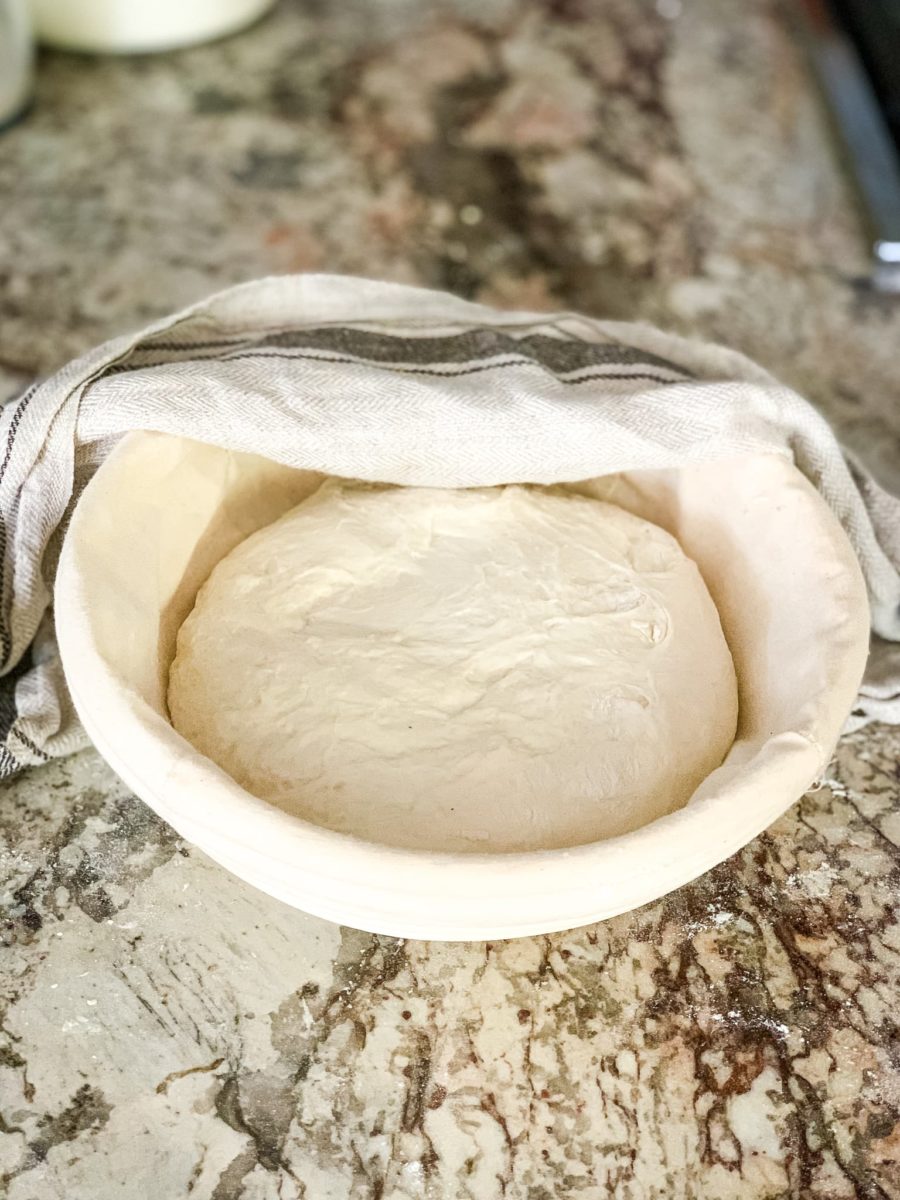
- In the morning, lightly flour your countertop. Remove the dough from the bowl and shape it by stretching and folding it again. Let the dough rest for 10 – 15 minutes.
Line a medium-sized bowl with a towel, use a banneton basket bowl with a linen cover, as shown above, and dust heavily with flour. Or line a large bowl with a clean kitchen towel and dust it heavily with flour.
Let dough rise in it for 45-60 minutes.
How to Bake Sourdough Bread
Preheat your oven to 450ºF.
Save This Recipe!
- Cover the dough bowl with a long piece of parchment paper, and turn it over onto the countertop (see the video below in the recipe card to see how this is done).
Next, score the top of the dough with a sharp knife or lame.
Use the parchment paper to lower your dough into the Dutch oven, as shown below.
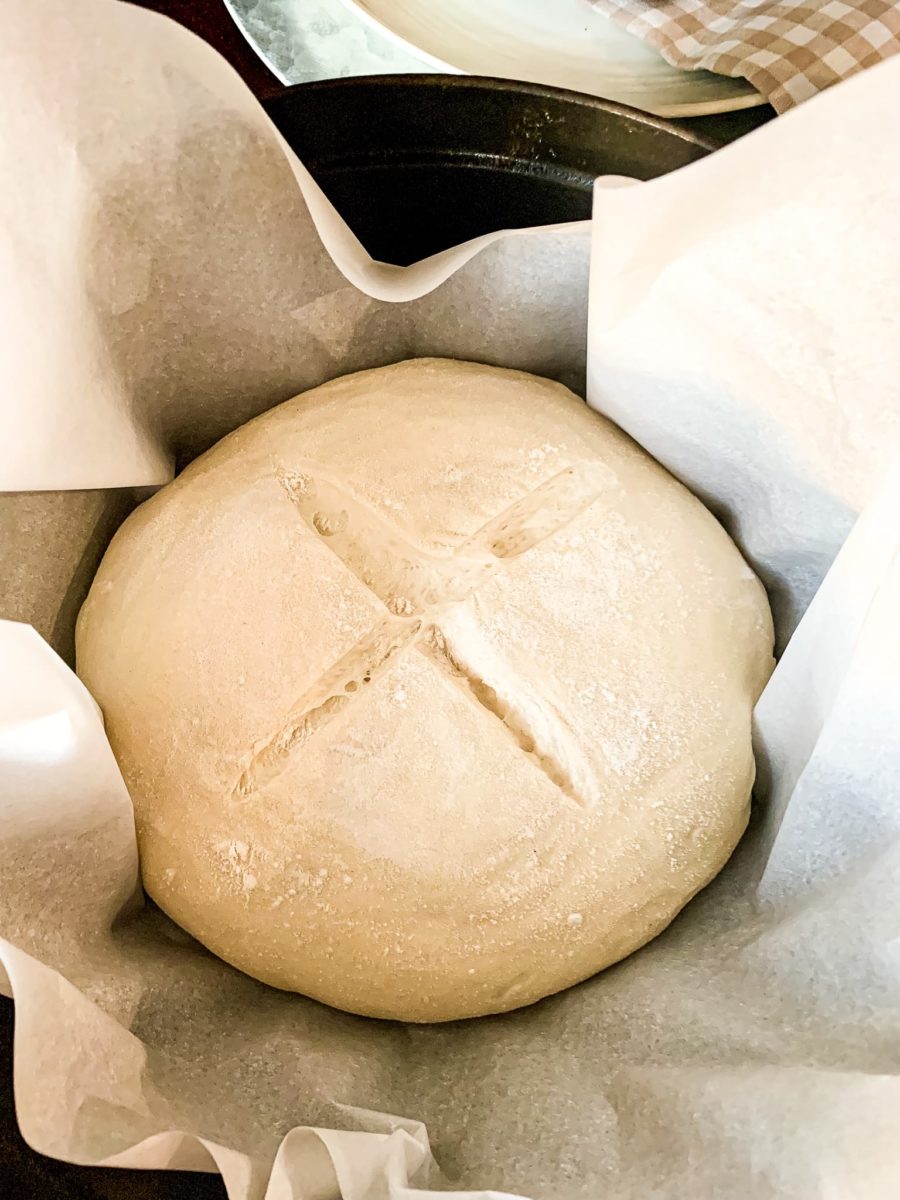
🎯 TFN Pro Tip
If you have a black-bottomed Dutch oven, I recommend using a round silicone sheet to keep the bottom of the loaf from browning too much. See below under “Troubleshooting Common Issues” for more information.
- Add the lid to the Dutch oven and bake covered for 30 minutes.
Then, remove the lid and bake uncovered for 20 minutes.
After that, carefully remove it from the pot and bake it directly on the oven rack for 10 minutes, to crisp the exterior.
After baking, let your loaf cool for at least one hour on a wire rack before cutting it. Otherwise, the loaf could deflate.
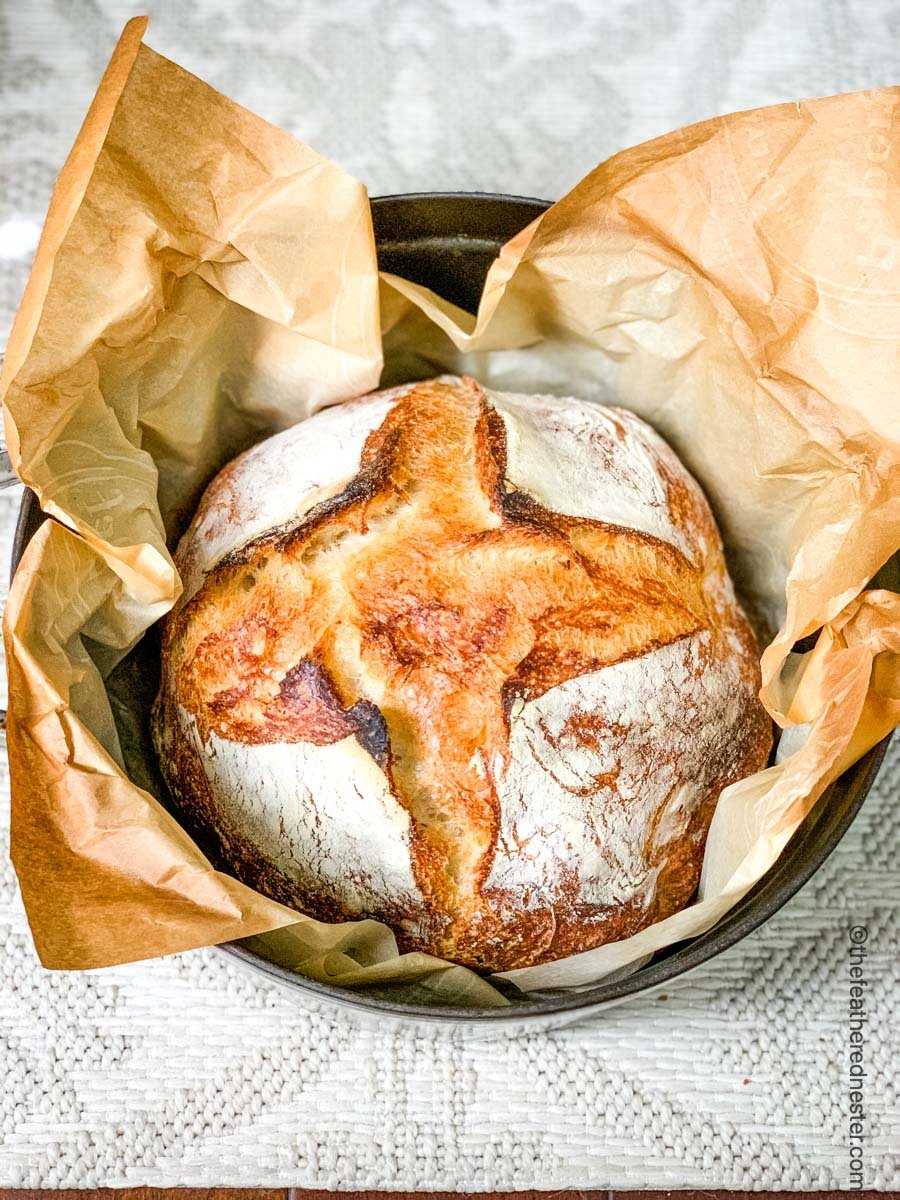
See our article on how to store sourdough bread for the best ways to keep your bread fresh.
Troubleshooting Common Issues
My sourdough bread did not double in size overnight.
If your starter is active (it doubles in size 4-6 hours after feeding) and was fed within 12-24 hours of starting the recipe, then your dough might not have been warm enough during the overnight rise.
Find a warm place (ideally 75º- 80º F) like a cool oven with the light on, a warm window, or above the refrigerator or dryer, and let it rise for another 2 hours. You might not see air bubbles on the top of the bowl, but they should be visible underneath. That’s why I recommend that beginners use a clear glass bowl as shown above.
What should I do if my dough is too sticky?
- Before the overnight rise: Sprinkle 1-2 tablespoons of flour on top of the dough and flour or wet your hands before stretching.
- After the overnight rise: The dough has likely not fermented enough. It should have doubled in size and show bubbles on the top and bottom. If not, see the notes above to let it rise for 1-2 more hours.
How can I keep the bottom of my bread from turning so brown?
An easy fix is to add a layer of cornmeal to the bottom of the Dutch oven and place the parchment paper on top of that. Or, use a 9″ round Silpat silicone sheet, as I do. I place it in the bottom of my Staub cast-iron Dutch oven.
Dutch ovens that are darker in color tend to brown the bottom of the loaf more.
Get more tips in our troubleshooting sourdough starter article.
Serving Suggestions
Sourdough bread is incredibly versatile. Enjoy its tangy flavor with hearty soups and stews, like toscana zuppa soup recipe where it soaks up rich broths perfectly. For a lighter option, create open-faced sandwiches with avocado spread for toast, turkey bacon, or caprese burrata. Slice it up and serve it with soft pretzel cheese dip or crab dip. Don’t forget classic pairings like butter and jam for a simple yet satisfying treat. Get creative and explore the endless possibilities of this delicious bread.
Recipe FAQs
Yes, a heavy oven-safe pot with a lid will work. Use one that is about 9″ to 10″ in diameter and 6″ high. Just be sure your pot and lid are rated for oven use of at least 450ºF.
Don’t use wax paper. The wax will melt in the oven at this high temperature and you’ll have a mess on your hands. Instead, use a long sheet of aluminum foil that has been sprayed with cooking oil.
Yes, our Dutch oven sourdough bread recipe uses all-purpose flour. Just let it rise overnight as in this recipe.
If you’re unsure if the bread is fully baked, the internal temperature should be around 195º – 200ºF.
You can easily soften stale bread in the microwave. Cover it with a damp paper towel and microwave it at 50% power for 30 – 60 seconds. However, I like using my leftover, hardened bread for sourdough stuffing or air fryer croutons.
If your starter is at least a week old and doubles in size within 4-6 hours after a feeding, then it should be ready to bake a loaf of sourdough. I don’t recommend using the float test – it’s never worked for me.
Yes, you can replace up to 1/2 of the all purpose flour with whole wheat flour for this recipe.
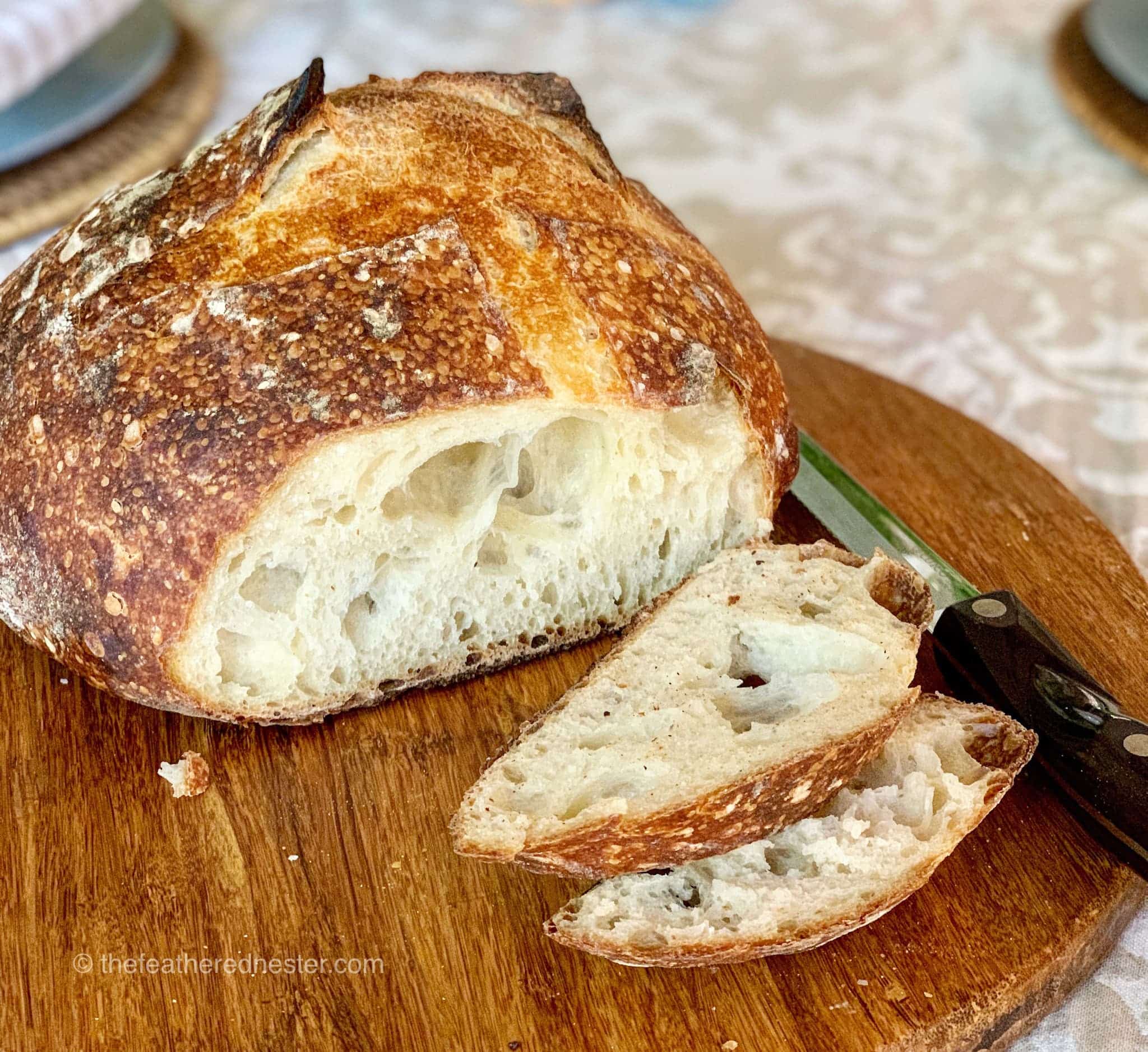
Other Sourdough Recipes to Consider…
If you tried this overnight sourdough bread recipe or any other recipe on my website, please leave a 🌟 star rating and let me know how it went in the 📝 comments below. Thanks for visiting!
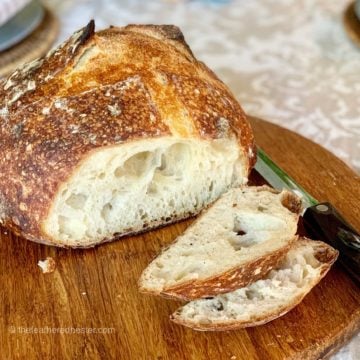
Easy Overnight Sourdough Bread
Equipment
- dough whisk - optional
- banneton proofing bowl - optional
- warming mat - (I recommend this if your room is cooler than 75ºF)
Ingredients
- ¼ cup (60 grams) active sourdough starter fed within 12-24 hours *see notes
- 1 ⅔ cups (350 grams) filtered or spring water about 100ºF or baby bottle warm
- 4 ¼ cups (500 grams) bread flour can substitute with all purpose flour
- 2 teaspoons (9 grams) fine sea salt
Instructions
- In a large bowl, add the sourdough starter. Add in water and use a dough whisk or a wooden spoon to stir until dissolved. Stir in the flour and salt until a shaggy looking dough forms. Finish mixing dough by hand in the bowl until all the flour has been absorbed. Cover the bowl with a clean, damp kitchen towel and let the dough rest for 30-45 minutes.
- Lightly flour your countertop. Pull the dough from the bowl with a dough scraper or by hand onto the countertop. Stretch and fold the dough for 15 seconds (see video below): grab the edge of the dough and bring it straight up it about 4 inches and tuck it into the center of the dough. Then, turn the dough 1/4 a turn. Continue this process until the dough has come full circle and it has tightened. Return the dough to the bowl, cover with a damp towel (or plastic wrap if you live in a dry area). Let rise overnight for at least 10 hours at room temperature or a warm location (72º and 80ºF degrees to ferment). Do not refrigerate the dough. The dough should double in size and look bubbly on the surface and under the dough when fermented.
- In the morning, lightly flour your counter-top. Pull the dough from the bowl and shape the dough by stretching and folding it again. Let the dough rest 10 – 15 minutes. Line a medium sized bowl with a towel, or use a banneton bowl with linen cover (see photos), and dust heavily with flour. Let dough rise in it for 45-60 minutes.
- Preheat your oven to 450ºF. Do not add your Dutch oven or baking pot, it does not get preheated. Cover the dough bowl with a long piece of parchment paper, about 20 inches long, and turn it over onto the countertop (see video). Slash the top of the loaf with a lame or sharp serrated knife. Gently lower the parchment paper dough into a heavy pot with a tight-fitting lid. NOTE: If using a pot with a dark interior cast iron pot, I recommend insulating the bottom with a round silicone sheet underneath the parchment paper. You can also place the Dutch Oven pot on a baking sheet. This helps the bottom crust of the bread from getting too dark in color.
- Place the covered pot in the the oven and bake the bread covered for 30 minutes. Remove the lid and bake 20 minutes. Using oven mitts, carefully remove the bread from the pot. Bake it directly on the oven rack for 5-10 minutes to crisp the exterior (if needed). To ensure your bread is cooked through you can check the internal temperature. It should be 195ºF to 205ºF.
Video

Notes
- If your starter is active (it doubles in size 4-6 hours after feeding) and was fed within 12-24 hours of starting the recipe, your sourdough might not be warm enough during the overnight rise.
- Find a warm place (ideally 75º- 80º F) like a cool oven with the light on, a warm window, or above the refrigerator or dryer to set the bread for 2 hours. Then continue with the recipe.
- Use a 9″ round Silpat silicone sheet, as I do. I place it in the bottom of my Staub cast-iron Dutch oven.
- Dutch ovens that are darker in color tend to brown the bottom of the bread more.



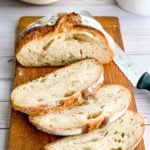



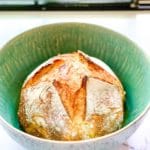
Sally says
This is my go to sourdough recipe. I know it by heart! Everyone loves when I bring them a loaf!
Jana says
Made three time now and did a little variation with the addition of raw cheddar cheese and jalapeños. Delicious! Thank you for sharing for those who are new to this ancient process. 🙂
Lois says
I have made this bread many times this year, always with good results. It’s the perfect starter (pun intended) loaf for those new to sourdough baking. Thank you for making is so easy!
Jaime says
This recipe never fails! I also get a perfect loaf! I do notice that I get more of a sour taste when I ferment in the fridge.. have not tried to do so with this recipe. Why is that?
Gianne - TFN Team Member says
The sour taste becomes more pronounced when fermenting sourdough in the fridge due to the extended, slow fermentation at cooler temperatures. When sourdough ferments slowly, lactic acid bacteria (LAB) and acetic acid bacteria have more time to develop and thrive. The LAB are responsible for a mild, tangy flavor, while acetic acid bacteria produce stronger, sharper sour notes, especially in cooler environments.
By refrigerating, you’re favoring these bacteria, which results in a more distinct sour flavor. If you’d like a milder flavor, you could try fermenting at room temperature or reducing the time in the fridge. Alternatively, experimenting with this recipe as is might yield new flavors!
Deborah Fosdike says
I’ve been using this recipe and it’s produced many yummy successful loaves! Super easy ina busy lifestyle and very taste and my gut is happy ( I’m gluten intolerant – not coeliac, so this bread doesn’t give me pain and bloating). Sooooo happy!